This article was written by Gro Harlem Brundtland, United Nations Foundation Vice Chair and former Prime Minister of Norway, and Kathy Calvin, President and CEO of the United Nations Foundation. It was originally published on Medium here.
Gender equality has long been a rallying cry in the development community, and calls have grown louder since world leaders adopted the Sustainable Development Goals at the United Nations last September. But good intentions are not enough to bring about equality, and right now the international community is missing a key ingredient for change: data.
Data is critical to development because it helps global decision makers identify and analyze social and economic problems, and then guides the investments that address these problems. But much of the data available — especially data that reflects the lives of girls and women, both independently and relative to boys and men — is incomplete or biased.
This begs the question: As we work to fulfill bold global promises to alleviate poverty and leave no one behind, how can we achieve gender equality if we do not have data equality?
We need to understand why gender data gaps exist. To begin with, many data collection systems have been built with an inherent gender bias that skews who is asking the questions, who is interviewed, and how the questions are worded.

For example, imagine a labor activity survey, which asks the head of a household questions about economic production. Households are, more often than not, considered “headed” by males. This means that surveys gather information from a man’s point of view, which may be very different from a woman’s perspective. A survey like this renders girls and women invisible through its questioning technique, and thus may yield the wrong conclusions about a woman’s labor activities. It may not discover that while, in some cases, the woman is not her family’s primary earner, she actually holds down multiple secondary and seasonal jobs, and her uncounted work in the home enables economic activity by others.
Because this woman’s life and experiences have not been prioritized by the data collection system, disadvantages caused by gender inequality cannot be detected or understood, which prevents practical solutions.
If data isn’t from all of us, then data isn’t for all of us. And biased, incomplete data won’t work. We need more and better gender data to have the complete data picture.
Fortunately, the Sustainable Development Goals give us an opportunity to refocus energy on getting gender data right.
Data2X, an initiative of the United Nations Foundation, is a collaborative technical and advocacy platform dedicated to improving the quality, availability, and use of gender data in order to make a practical difference in the lives of girls and women worldwide.
We are working with groups that head major data collection efforts — UN agencies, country governments, international non-profits, academic researchers, and international financial institutions — to improve civil registration and vital statistics systems for girls and women, test big data’s potential for insights on gender, and crack the code on measuring women’s economic contributions, among other steps.
But we need more than these kinds of partnerships. If we really want to achieve gender equality, we need leaders from every sector to help start the gender data revolution. Here is what we can do:
Leaders of countries: Increase the supply of, and demand for, accurate gender data by prioritizing and investing in data collection in your country and mandating data collection processes that include a gender perspective. Use gender data to design or improve national programs and policies.
Leaders of philanthropies, non-profits, and social enterprises: Closely examine data to make sure it is not inherently biased. Invest in gender data improvement and use. Engage stakeholders on what gender data is and why we need it. Build demand within the global development community for better gender data.
Corporate CEOs: Increase disaggregated data collection and openness to understand how women participate throughout supply chains, as well as the number of female and male customers. This data has significant implications for counting women’s economic production and for understanding the scope and differences of the women’s market.
Statisticians, data scientists, and surveyors: Be alert to and expose unconscious gender bias. If it is hard to collect data on certain groups of people, find creative and actionable solutions.
Individuals: Push for more and better gender data from government, non-profit, and corporate sources. Demand that fundamental forms of data are strengthened, available, and accessible to all. Utilize gender data to track progress at sub-national, national, and global levels.

From May 16–19 in Copenhagen, thousands of leaders and advocates will come together at the Women Deliver conference to discuss strategies for empowering girls and women. Gender equality will once again be a rallying cry. This time, shouts for gender equality must be matched by shouts for gender data.
No girl or woman should be invisible. No one should be left behind. To achieve gender equality, we must commit to data equality.
The views expressed here are not necessarily those of each of the partners of Global Citizen.